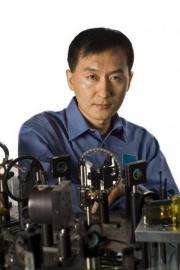Laser technology creates new forms of metal and enhances aircraft performance

AFOSR-funded researchers at the University of Rochester are using laser light technology that will help the military create new forms of metal that may guide, attract and repel liquids and cool small electronic devices.
Dr. Chunlei Guo and his team of researchers for the project discovered a way to transform a shiny piece of metal into one that is pitch black, not by paint, but by using incredibly intense bursts of laser light. The black metal created, absorbs all radiation that shines upon it.
"With the creation of the black metal, an entirely new class of material becomes available to us, which may open up a whole new horizon for various applications," said Guo.
"To do this, we looked at the reverse process of light absorption or light radiation and transformed the incandescent lamp into a bulb that glows twice as brightly as a regular light source, while consuming the same amount of energy," he said.
The key to creating this super-filament is an ultra-brief, ultra-intense beam of light called a femtosecond laser pulse. The laser burst lasts only a few quadrillionths of a second. That intense blast forces the surface of the metal to form nano-structures and micro-structures that dramatically alter how efficiently light can radiate from the filament.
In addition to increasing the brightness of a bulb, Guo's process can be used to tune the color of the light as well. Last year, his team used a similar process to change the color of nearly any metal to blue, gold, gray, in addition to the black. They controlled the size and shape of the nano-structures -- and thus what colors of light those structures absorb and radiate -- to change the amount of each wavelength of light the filament radiates.
In addition to this research, Guo and his team have been working on creating technology that may enable the Air Force to create an additional kind of metal. They are able to do this by using the femtosecond laser once again to alter the surface of metal and create unique nano- and micro-scale structures on the metal.
"During its brief burst, the laser unleashes as much power as the entire electric grid of North America does, all focused onto a spot the size of a needle," said Guo.
The unique nano-structures which are created from the laser affect the way liquid molecules interact with metal molecules. The liquid spreads out over the metal because the nano-structures attach themselves to the liquid's molecules more readily than the liquid's molecules bond to each other. The end result is the formation of a new kind of metal that can cool the plane's electronic brain and heat pumps and allow the craft to retain dominance over any enemy that is also in flight.
Currently, the researchers need only about half an hour to change the surface of metal that is approximately the size of a quarter. Nevertheless, their next goal is to make the metal even more quickly so they can meet the ever increasing demands of warfighting.
Source: Air Force Office of Scientific Research


















